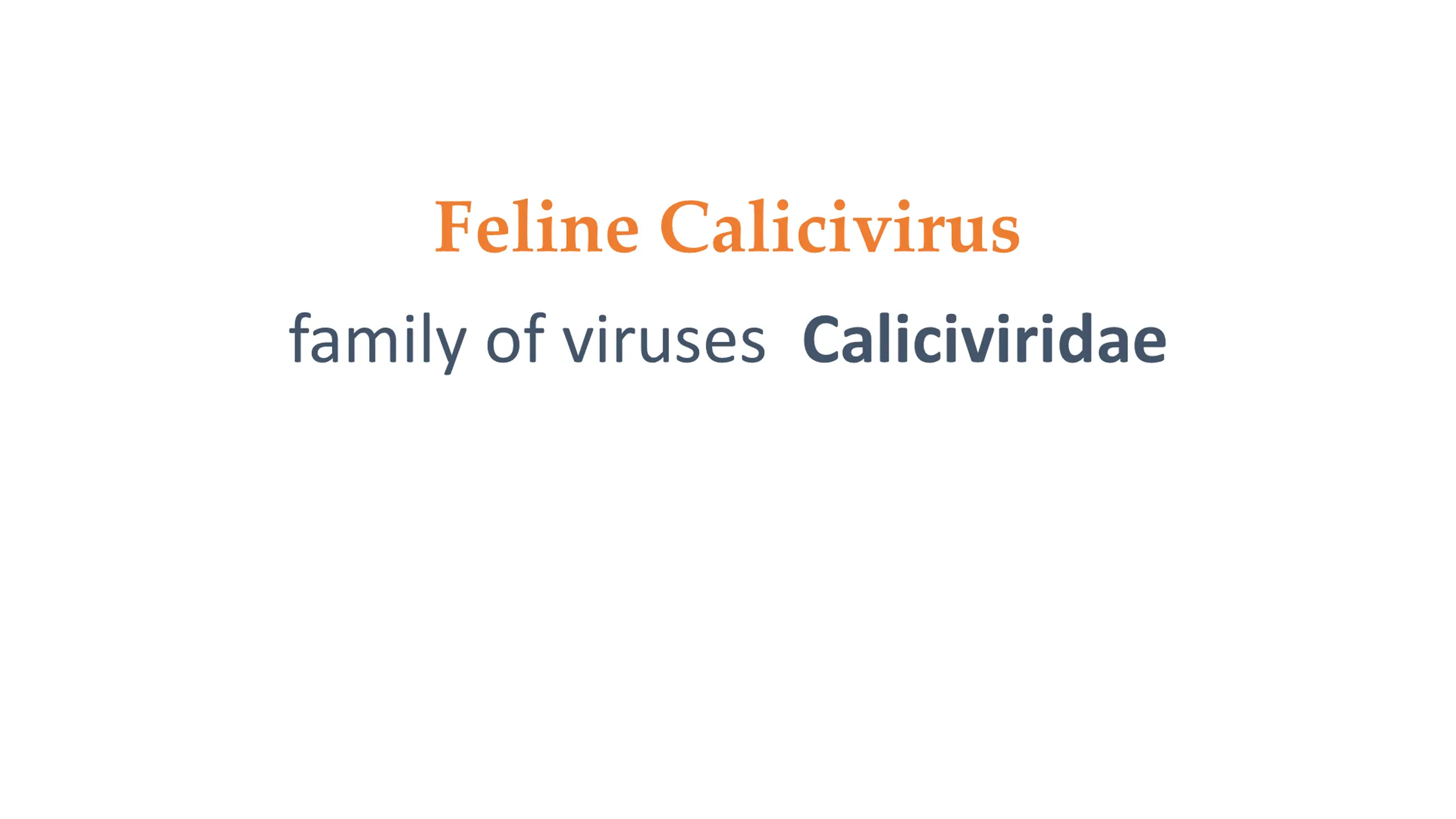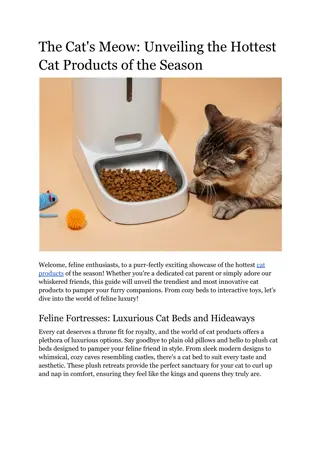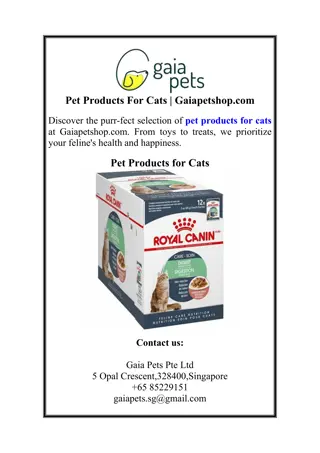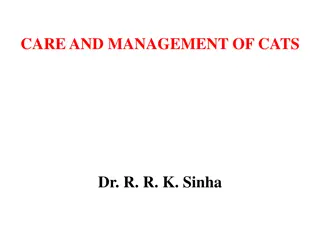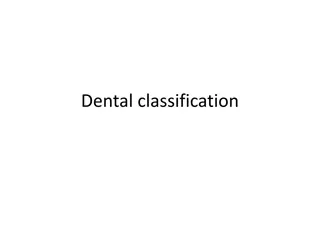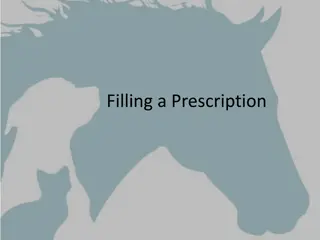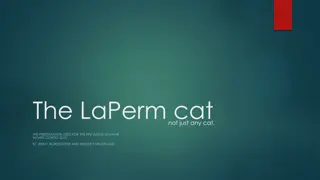Feline Calicivirus
Feline Calicivirus (FCV) is a highly contagious virus that causes respiratory infection and oral disease in cats. It spreads easily in multi-cat environments like shelters and breeding colonies. Learn more about its causes, transmission, and prevention.
Download Presentation

Please find below an Image/Link to download the presentation.
The content on the website is provided AS IS for your information and personal use only. It may not be sold, licensed, or shared on other websites without obtaining consent from the author.If you encounter any issues during the download, it is possible that the publisher has removed the file from their server.
You are allowed to download the files provided on this website for personal or commercial use, subject to the condition that they are used lawfully. All files are the property of their respective owners.
The content on the website is provided AS IS for your information and personal use only. It may not be sold, licensed, or shared on other websites without obtaining consent from the author.
E N D
Presentation Transcript
Feline Calicivirus family of viruses Caliciviridae
Feline calicivirus is a highly contagious virus that causes a mild to severe respiratory infection and oral disease in cats. It is especially common in shelters and breeding colonies, and often infects young cats. Most cats recover completely after a calicivirus infection, but rare strains can be especially deadly.
Causes Feline calicivirus (FCV) belongs to a large family of viruses named Caliciviridae. whose members infect a wide range of vertebrate animals, including rabbits, livestock, reptiles, birds and amphibians.
The human virus norovirus, which causes a brief but unpleasant gastrointestinal disease, is also a member of the Caliciviridae family. Several strains of FCV circulate in domestic and wild cats. The virus mutates readily, leading to new strains that may not be fully covered by existing vaccines. Strains vary in the severity of the disease that they cause, with the majority causing only mild disease.
How cat become infected. FCV occurs most commonly in multi-cat environments. A cat s risk of exposure is higher in shelters, pet stores, and catteries, where 25 -40% of cats may be carriers. The virus spreads through : direct contact with the saliva, nasal mucus and eye discharge of infected cats and through aerosol droplets that spread when cats sneeze. also detected the virus in urine, feces and blood. Cats typically shed the virus for about weeks after infection, but some cats become long-term carriers, and continue to shed the virus on and off for months.
FCV is a hardy virus that survives on surfaces for up to a month in certain environments. Humans that handle infected cats can inadvertently transfer the virus to new animals. Objects that come in contact with a cat s bodily fluids, such as food bowls, litter boxes or bedding, can also be a source of infection. the virus also can be passively carried to susceptible cats by human handlers. All felids are apparently susceptible to feline calicivirus infection. The virus has been isolated from a dog,
Pathogenesis After being exposed to FCV, the incubation period is 2-14 days before symptoms appear. -Predisposing factors ,General Following oronasal infection the virus multiplies in the tissues of the oropharynx and the respiratory tract. Oral ulcers which are a frequent feature of the disease begin as thin-walled vesicles which quickly ulcerate.
- Less commonly the lower respiratory tract has signs of pathology with the development of areas of acute exudative pneumonia. -In some cats the joints are a site of viral infection causing an acute synovitis with thickening of the synovial membrane and increased quantities of synovial fluid. -The pathogenesis of the more recently reported hemorrhagic/hepatic syndrome includes vasculitis, coagulopathy and necrosis of skin -with clinical lesions of edema, skin necrosis and coagulative necrosis of hepatic tissues and pathology in the pancreas.
Symptoms and complications symptoms will depend on the strain of FCV it contracts. At first the cat will have symptoms that look like a cold, with sneezing, nasal congestion, fever and sometimes drooling. Large amounts of discharge can come from the eyes and nose. In more severe cases, cats can also develop inflammation and ulcers on the tongue, and the lining of the mouth. Lethargy, mild lameness and lack of appetite may also occur. These symptoms can persist from 5-10 days in mild cases and up to 6 weeks in more severe ones.
During the course of the illness, opportunistic bacterial infections can also occur. Cats may lose weight, and the infection can also cause abortions in pregnant cats. Most cats recover completely, but some will go on to develop a chronic form of gingivitis that causes thick and inflamed gums, which makes eating painful. Elderly cats and young kittens are more likely to suffer more severe symptoms.
Cats that develop FCV-VSD ( sporadic outbreaks of virulent systemic disease (FCV-VSD). The basis for the increased pathogenicity of FCV-VSD viruses )will have much more severe symptoms, including a high fever, swelling of the head and legs, as well as crusting sores and hair loss on the nose, eyes, ears and footpads. The mouth and ears may turn yellowish from liver damage, and there may be bleeding under the skin and in the gastrointestinal tract. FCV-VSD is fatal in up to 60% of cats that develop the disease.(multiple organ damage or even death, called FCV-associated virulent systemic disease or FCV-VSD)
Tests and diagnosis FCV causes about half of the respiratory infections that occur in cats, but feline alphaherpesvirus1 (sometimes called feline rhinotracheitis virus) is another common cause and sometimes dual infections occur. The bacterial species Chlamydia felis and Mycoplasma felis also cause respiratory disease, and may complicate FCV infections. A veterinarian will examine the cat for symptoms. In most cases, there is no need to make a definite diagnosis, as these infections are common and will resolve with supportive treatment. However, if multiple cats are infected or the cats are housed with others, the veterinarian may take swabs from the eyes, nose or mouth. These swabs will be sent to the lab to test for the presence of the virus. Labs can also test tissue or serum samples.
Treatment Currently there is no treatment to stop the virus, but pet owners can offer supportive care for Currently there is no treatment to stop the virus, but pet owners can offer supportive care for their cat while its immune system fights the infection. their cat while its immune system fights the infection. Most cats can recover at home, but severely affected cats may need intensive nursing care. Most cats can recover at home, but severely affected cats may need intensive nursing care. For most cases of feline For most cases of feline calicivirus Because of the likelihood of secondary bacterial infections, cats with Because of the likelihood of secondary bacterial infections, cats with calicivirus prescribed antibiotics to take by mouth. They may also have you clean their eyes and nose prescribed antibiotics to take by mouth. They may also have you clean their eyes and nose routinely and prescribe antibiotics to put in the eyes if they have eye infections. routinely and prescribe antibiotics to put in the eyes if they have eye infections. calicivirus, treatment aims to relieve respiratory and oral discomfort. , treatment aims to relieve respiratory and oral discomfort. calicivirusoften get often get Keep the nose and eyes of the cat clean and use vaporizers and saline nose drops to help clear Keep the nose and eyes of the cat clean and use vaporizers and saline nose drops to help clear the nasal passages. the nasal passages. A drug that breaks down mucus, like A drug that breaks down mucus, like bromhexine bromhexine, also can help reduce congestion. , also can help reduce congestion.
If cat has significant congestion, veterinarian may prescribe a nebulizer to deliver a fine mist to break up respiratory secretions. Another at-home option is to take your pet into the bathroom, shut the door, and turn the shower on warm for 10-15 minutes to create steam for your cat to inhale. Some cats may require fluid support to prevent dehydration. In mild cases, the veterinarian may give the fluids under the skin For ulcers in the mouth, veterinarian may prescribe oral pain medications or topical medications that are meant to coat the ulcers and relieve pain. Because the ulcers cause pain and the congestion affects the cat's sense of smell, they may need appetite stimulants or a temporary feeding tube in severe cases. At home, can offer them strong-smelling canned food and heat it up in the microwave to enhance its smell.
Non-steroidal anti-inflammatory drugs can lower the fever and reduce mouth pain, and broad-spectrum antibiotics can be used to treat opportunistic bacterial infections, when necessary. Cats often lose their appetite and stop eating due to congestion and the sores in their mouths. Owners should provide strong-smelling, soft foods, which can be pureed to make them easier to swallow and heated slightly to increase their odor. If cats have not eaten for more than three days, they may need hospitalization to receive fluids and IV nutrition.
Prevention vaccines do not protect against FCV entirely, but they can greatly reduce the severity of the infection if cat is exposed. Several combination vaccines against FCV, feline herpesvirus type 1 and feline panleukopenia virus (the cause of feline distemper) are available, which can be given nasally or as an injection. The vaccines given nasally contain a modified live form of the virus, while injected vaccines can be modified live viruses or inactivated ones. Cats that receive the nasal vaccine may sneeze for 4-7 days after vaccination.
Once kittens reach 6-8 weeks of age, they should receive a vaccine every 3-4 weeks, with the final booster being given after 16 weeks of age. If the cat is already older than 16 weeks, give 2 doses of the vaccine, 3-4 weeks apart. Cats should receive boosters every 3 years, unless they are in a high- risk, multi-cat environment, in which case they should be revaccinated annually. Even cats that have recovered from a calicivirus infection should receive boosters, because they may not be protected against other strains of the virus. Studies suggest that the nasal form of the vaccine leads to more rapid protection against the virus, which may be helpful in containing outbreaks in shelters.
A vaccine called Calicivax is available that includes modified forms of a strain of FCV that causes FCV-VSD, and a typical strain of FCV. This vaccine may offer some protection against outbreaks of FCV-VSD, but since the virulent strains that cause these outbreaks arise from different mutations in less aggressive strains, it is unknown how effective Calicivax will be against future outbreaks. Calicivax is not part of the set of core vaccines recommended for all cats.
